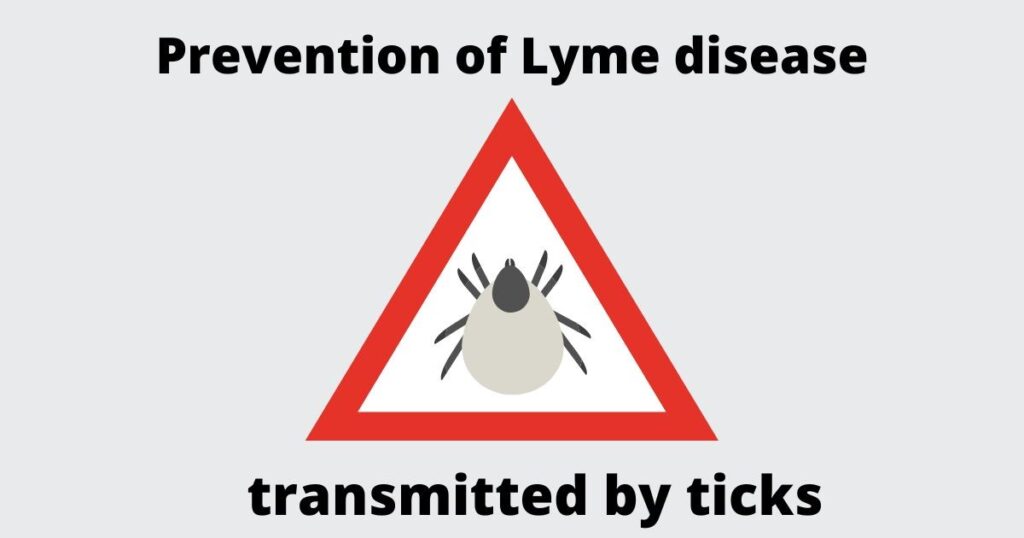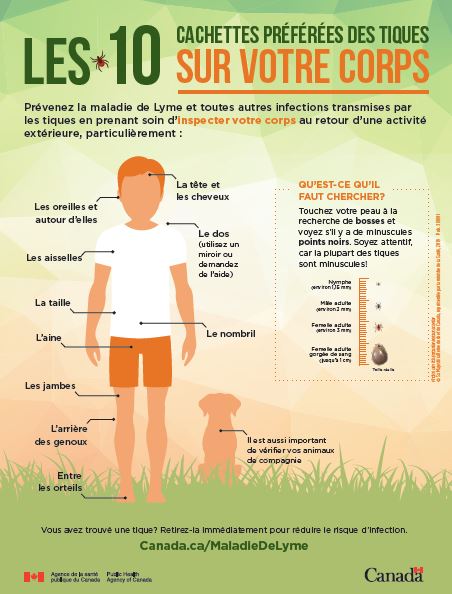Lyme disease: take precautions against ticks

Lyme disease is transmitted by the bite of a tick carrying the Borrelia burgdorferi bacteria.
A dozen species of ticks are present in Quebec. Since ticks can be carried by birds, they can be found in almost all regions of Quebec. However, not all ticks carry the bacteria. The only species that can transmit Lyme disease in Quebec and northeastern North America is the Ixodes scapularis tick, also known as the “deer tick” or “blacklegged tick”. This tick is particularly present in the Eastern Townships.
This tick can also transmit other diseases, including anaplasmosis (A. phagocytophilum): consult the document Les infections transmises par les tiques : au-delà de la maladie de Lyme from the Direction de santé publique de la Montérégie.
Prevention
Ticks do not jump, fly or drop from a high surface (such as a branch). They can, however, cling to you or your pet when you come in contact with plants in a garden, landscaping, forests, woodlands and tall grass. The best way to avoid getting Lyme disease is to avoid tick bites when doing outdoor activities such as gardening, hiking, golfing, hunting, fishing, camping, etc.
When walking, to avoid tick bites:
- Walk preferably on trails and avoid tall grass;
- Use mosquito repellent on exposed parts of your body, avoiding the face. Follow the instructions for using mosquito repellent;
- Wear a hat, closed shoes and long clothing;
- Tuck your shirt into your pants;
- Tuck the bottom of your pants into your socks or boots;
- Wear light coloured clothing when walking. Light colors make ticks more visible.
When you return from an outdoor activity, to spot a tick:
- Check your entire body;
- Take a bath or shower as soon as possible, ideally within 2 hours of the outdoor activity, to check for ticks. This will also remove any ticks that are not firmly attached to the skin;
- Have someone else help you or use a mirror to check less visible areas such as the back. Also, use bath time to examine children;
- Examine your equipment (backpack, coat, etc.). This is to avoid bringing a tick into your home, where it could bite someone or a pet;
- Remove ticks from your clothing by putting it in the dryer on high heat for 10 minutes. If the clothes are too dirty to put in the dryer directly, machine wash them in hot water, ideally for at least 40 minutes. Then put them in the dryer on high for at least 60 minutes. The clothes should be completely dry;
- Check your pets as well, as they can bring ticks into your home. If you find ticks on a pet, remove them and consult a veterinarian if necessary. For more information on ticks on pets, visit the Ministère de l’Agriculture, des Pêcheries et de l’Alimentation website
For more information on how to avoid tick bites and reduce the presence of ticks in your environment, see the Protection and Prevention section of the Lyme Disease page.
Description of the tick
Ixodes scapularis ticks live primarily in humid places such as forests, wooded areas, tall grass, gardens, landscaping and piles of dead leaves.
Ticks will be found at various stages of development (larva, nymph, and adult) in the same area throughout the year.
At each of these stages, ticks must feed on animal or human blood to go on to the next stage.
Before feeding, ticks can vary in size between 1 and 3 millimetres. Ticks can triple in volume when filled with blood, which makes them easier to detect in case of bites. Nymphs are smaller (the size of a poppy seed), often go unnoticed and generally stay attached to the person’s skin longer before they are detected. They are more active in the spring and summer months.
Ticks can be active from 4°C. The risk of being bitten is present mainly in spring and summer, but it persists until fall. During this period, it is important to protect yourself. The risk of infection is as much for animals as for humans.
Symptoms and treatment
Tick bites are usually painless and often go unnoticed.
After outdoor activity that may allow exposure to ticks, it is important to examine your skin to detect the presence of ticks and remove them as soon as possible.
If you spot a tick, remove it by following the steps on the Removing a Tick after a bite page.
Lyme disease symptoms can vary from person to person. It is important to watch for symptoms so that the disease can be detected and treated quickly. The first symptoms of Lyme disease usually appear 3 to 30 days after being bitten by a tick that carries the bacteria.
The most common symptom is a skin rash that is not usually painful or itchy. It develops at the site of the bite, most frequently on the thighs, groin, armpits or torso. It may sometimes occur in areas that are hard to see, such as behind the knees, the lower buttocks or back, the scalp, behind the ears, the eyebrows, the bellybutton or between the toes. A rash develops in 60% to 80% of cases of infection but is not always noticed. It is present for at least 48 hours and expands rapidly until it is over 5 centimetres in diameter. The rash may be circular or look like a bull’s eye. It is sometimes very pale and its edges may be poorly defined.
Some people also experience fatigue, fever and muscle aches.
If the disease is not detected and treated quickly, the bacteria can spread in the blood and cause other symptoms, which develop in the weeks and months after the bite. These symptoms may, for example, include:
- The appearance of several expanding rashes, with little or no pain or itching
- Facial paralysis, numbness in a limb, neck pain, severe headaches
- Swelling in one or more joints (for example, the knee); it is usually painless
- Chest pain, palpitations or dizziness
When to seek medical help
If you have been bitten by a tick in an area where the risk of contracting the disease is high, which is the case in the Eastern Townships, you may be prescribed a preventive antibiotic treatment: you can ask your pharmacist.
If you develop a rash after possibly being exposed to ticks, you can draw around the rash with a pen and take a photo. This way, you can check if the rash expands.
Call Info-Santé 811 or see a doctor if any of the following applies to you:
- The rash is 5 cm in diameter or larger
- The rash lasts more than 48 hours
- You believe you have one or more other symptoms of Lyme disease within days, weeks or months after engaging in outdoor activities where you may be exposed to ticks
If you have noted a bite, provide the information you noted concerning the bite:
- The part of the body that was bitten
- The date and the place you were when you were bitten
If you consult a doctor, bring the tick, if possible, in a closed container such as a pill container.
Where does the name Lyme disease come from?
This disease was first described in 1977 following an outbreak of arthritis in children living in the town of Lyme, Connecticut in the United States.
Links of interest
- The Town of Bromont, in collaboration with the Direction de santé publique de l’Estrie, is participating in a research project conducted by a team from the Université de Montréal in order to improve the prevention of Lyme disease: consult the research project (in French).
- Lyme Disease Fact Sheet | Before a Tick Bites You
- Public Health Agency of Canada | Lyme Disease
- Institut national de santé publique du Québec | Lyme disease and tick-borne diseases (interactive map by municipality) (in French).
Source: Government of Quebec



